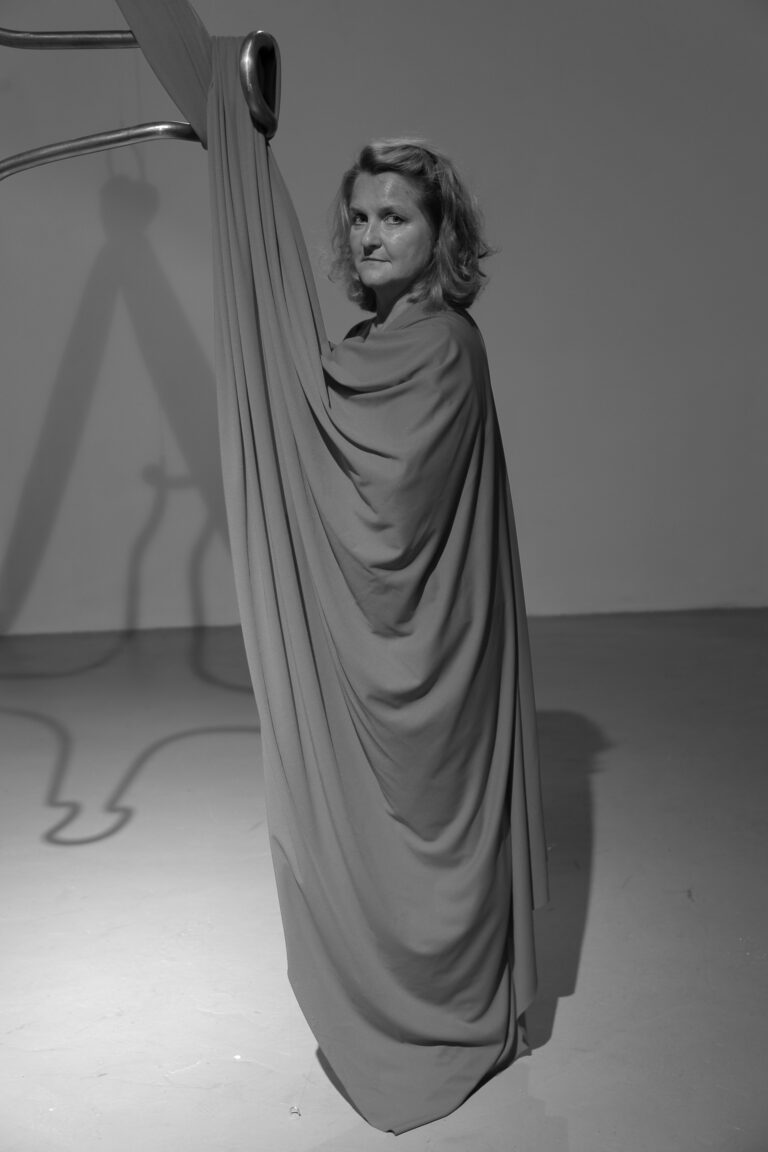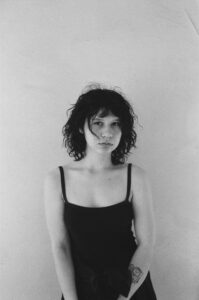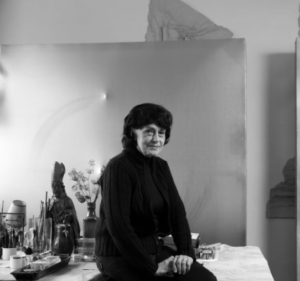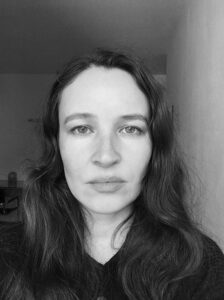Milena Dopitová

– born 1969, in Šternberk in Czechoslovakia. She is a visual artist and in her conceptual works she is dealing with social themes — issues of birth, adolescence, ageing and death, as well as with themes of bodily and gender identity, which she tackles from the point of view of individual experiences of everyday life. Monday, in the 1990s, she participated in many international art exhibitions — such as the Sydney Biennale (1992), the Venice Biennale(1993), the Sāo Paulo Biennale (1994), and Gwangju Biennale (1995). She is currently running the Studio of Intermedia I at the Academy of Fine Arts in Prague.
Monday is Sunday
My work has a lot to do with how my life is developing. I usually process lived situations, experiences, the atmosphere of events, social relationships. I do not perceive the act of looking back as a set direction for the future, but as a mosaic that constructs an image that asks where we have come from and what we have caused. It reflects, investigates and doubts the existing certainties, preparedness for alternatives and tolerance to a different opinion. It is amazing that visual art has the power to affect the viewer. It can fulfil them, it can influence their mind and consciousness. I like to write down sentences taken out of their context, things that I hear, for example, on the street, in a movie, or read them in other connections. I have them in my diaries and notes, and they are magic spells and a challenge to discover new content, often being an impulse to create new projects. In addition to identity, hygiene, youth, change over time and memory, I am also interested in topics related to social conditions, which have often been on the margins of interest, regardless of whether they were projects related to old age or death1234567.
I am not as interested in old age per se as in the opposite of the consumer ideal — although controversy related to ageing is also a part of my work, of course (Sixtysomething, 2003)89. More importantly, I perceive old age as a social problem. For each of us, this stage of life is a certainty that will not pass us by, and the living conditions that we are now imposing on the elderly will catch up with us sooner or later. Even the term “productive age” is just a justification. In our country, most people can rely at least on a state pension, but in the United States, for example, the elderly can often find themselves literally on the streets if they had not saved up any capital. The general indifference and contempt for old age deprive this generation of the joy of life, self-confidence and the ability to act. I recently have heard a very precise statement regarding this subject: ‘old age is courage’. In addition to the reflection of more general social problems, conveying a statement that is as personal as possible is also an important aspect of my work, such as the topic of my personal identity that has been processed several times already. The fact that I am one of two identical twins has been an inspiration for me. This aspect of my life then brings the question of authenticity and the study of the closest interpersonal relationships into my work1011121314.
Art cannot change the world. Whenever I pointed out the problems in society in my work, I did not want to convince the viewer of something or demonstrate my moral superiority, but to encourage them to start thinking about the issue themselves. In the confrontation with the viewer, I try to leave space for their own reasoning and judgment, even if it were to be completely different from what I myself wanted to express. I’m not afraid that someone will misunderstand my concept. Even a different interpretation is a result of the viewer’s reaction, which is always valuable15.
The 1990s were a great work euphoria, it was just one project after another. Foreign curators and theorists who were very interested in the local scene were coming to the Czech Republic. It was a time of great motivation and new experiences, similar to those that I had at foreign art exhibitions. From this period, I remember above all how heavily stressed I was not to miss anything. Around the year 2000, many of these contacts disappeared. I think that at the time we did not know how to develop these acquired opportunities further and move forward to become a part of foreign institutional networks. It was also the time when feminism began to be discussed within the art scene. Despite the generally negative attitude towards feminism, contemporary discussions also stemmed from the fact that a strong generation of female artists emerged on the scene and this new phenomenon had to be taken into account. I remember that an exhibition featuring exclusively male artists, titled Like Women (1993), was organised as a response to this emerging generation of women. Even though the concept of this exhibition was presented in a rather humorous context, I felt that the participation of some artists originated in the uncertainty of what this situation would bring and insecurity about the extent to which it could weaken the exclusively male society of this field16171819.
Over the years, I have gradually developed a positive relationship with feminism. I support the promotion of gender equality in society, but in my work, I never take feminism as a starting point or a programme on which my thinking should be based. I understand the term “feminist artist” as a designation of a personality who methodologically works with feminist topics and might be an activist. I approached the content of these themes intuitively, through the presentation of my own experience. If I were to evaluate my work from this point of view, I would say that aspects of feminist thinking can be discovered within it20.
I come from a family in which my mother and father had a very harmonious relationship. Chores of our household were evenly distributed. On the contrary, my sister and I sometimes felt that our mother was ruling the house and our father was balancing her out. That’s why we laughed at scenes from the series from the era of normalisation, in which a man came home from work, lay down on the couch and pulled out a newspaper, and the woman was beyond herself not knowing where to jump first. Our father was a designer, our mother a teacher. Both were passionate and happy with their jobs. Maybe that is why I chose a vocation that I don’t perceive as a job. And I tried to use this in the upbringing of my son as advised him to choose a profession that would entertain and fulfil him — then he would not even feel the difference between Sunday and Monday. One is then always pleased with what is coming, even if it is sometimes labour-intensive. They might be tired but they are happy.
The text was created in collaboration with Marianna Placáková (2021).
1Kateřina Černá, I'll be there for a while, interview with Milena Dopitová, "Art & Antiques", 2011(9), see: https://www.artantiques.cz/jeste-chvili-se-zdrzim.2See: https://vltava.rozhlas.cz/milena-dopitova-zajimaji-me-tabuizovane-otazky-6489486#volume.
3See: https://vltava.rozhlas.cz/intimni-koreny-mileny-dopitove-5063091.
4Image: Milena Dopitová, I Do Not Expect to Change I, 1993, iron construction, wool. Courtesty of the artist.
5Image: Milena Dopitová, Follow Me, 1994, ceramic tiles, wooden construction, mechanic motion. Courtesty of the artist.
6Image: Milena Dopitová, Your Spell Can Make Me Well, 2011, colour photographs. Courtesty of the artist.
7Image: Milena Dopitová, To Shave, to Make-up, 1999, single channel video. Courtesty of the artist.
8Marek Pokorný, Milena Dopitová. Sixtysomething, 2003, Galerie Jiří Švestka – Ronald Feldman Fine Arts, Prague.
9Image: Milena Dopitová, Sixtysomething, 2003. Courtesty of the artist.
10Milena Dopitová, Twins (Me and my sister), 1991, see: http://www.milenadopitova.cz/?page=fotka1.
11Gabriela Bukovinská, Milena Dopitová, Labyrint, 2004, č. 15–16, s. 87-88.
12Olga Mala, Milena Dopitova, I love & accept, 2014, Gallery of the Capital City, Prague.
13Josef Ledvina, The Great and Kind, 2014, [in:] "Art & Antiques", see: https://www.artantiques.cz/velike-a-laskave.
14Image: Milena Dopitová, Twins (Me and my sister), 1991,installation, wooden construction, wool, photograph. Courtesty of the artist.
15Martina Pachmanová, May I ask? With Milena Dopitová on the art and cycle of human life, The Artist, 2005, No. 1, http://divus.cc/praha/cs/article/may-i-have-this-dance.
16Charlotta Kotík, Post-Totalirian Art: Eastern and Central Europe, [in:] Maura Reilly, Linda Nochlin (eds.), "Global Feminisms. New Directions in Contemporary Art", New York, Brookly Museum 2007, s. 161, 162.
17Martina Pachmanová (ed.), Milena Dopitová. Even the same is different, Academy of Fine Arts,Prague, 2017.
18Marek Pokorný, Pavel Liška, Milena Dopitová. Installations 1992–1999, House of Art, Brno, 1999.
19Milena Dopitová, We Were in the Right Place at the Right Time, see: http://testimonies.umprum.cz/en/milena-dopitova.html.
20Martina Pachmanová, Miracles of Everyday Life. Interview with Milena Dopitová, [in:] "Pavlína Morganová, Sometimes in a Skirt. Art of the 1990s", Moravian Gallery, 2014, pp. 92–98.
– narozena 1969 ve Šternberku v Československu, vizuální umělkyně, ve svých konceptuálních dílech se zabývá sociálními tématy – otázkami zrození, dospívání, stárnutí a smrti, dále tématy tělesné a genderové identity, které pojímá z pohledu individuálního prožívání každodennosti, v roce 1989 stála u zrodu umělecké skupiny Pondělí, v devadesátých letech se zúčastnila mnoha mezinárodních přehlídek umění – např. bienále v Sydney (1992), Benátkách (1993), Sao Paulu (1994), Kwangdžu (1995), v současnosti vede Ateliér intermediální tvorby I na Akademii výtvarných umění v Praze.
V pondělí je neděle
Moje práce hodně souvisí s tím, jak se vyvíjí můj život. Většinou zpracovávám odžité situace, zkušenosti, atmosféru událostí, společenských vztahů. Zpětný pohled nevnímám jako nastavený směr do budoucna, ale jako mozaiku, jež sestavuje obraz, který se ptá, odkud přicházíme a co způsobujeme. Reflektuje, hledá a pochybuje o stávajících jistotách, připravenosti k alternativám a k toleranci k jinému názoru. Je úžasné, že vizuální umění má tu moc působit na diváka, může ho naplňovat, ovlivňovat jeho mysl i vědomí. Ráda si zapisuji věty vytržené z kontextu, které slyším například na ulici, ve filmu nebo je čtu v jiných souvislostech. Mám je v denících a poznámkách, jsou kouzlem i výzvou k objevení nových obsahů a mnohdy impulsem k vytvoření dalších projektů. Vedle identity, hygieny, mládí, proměny v čase, paměti mě zajímají i témata týkající se sociálních podmínek, jež mnohdy stály na okraji zájmu, ať už to byly projekty spojené například se stářím nebo smrtí1234567.
Stáří mě nezajímá ani tolik jako opak konzumního ideálu – i když polemika s ním je součástí mých pracích samozřejmě také (Sixtysomething, 2003)89. Daleko víc vnímám stáří jako sociální problém. Pro každého z nás je tato životní etapa jistotou, která nás nemine a podmínky pro život, které nyní nastavujeme těm starším, nás dostihnou dříve nebo později. I označení „produktivní věk“ je celkem výmluvné. U nás se většina lidí může spolehnout alespoň na státní penzi, ale třeba ve Spojených státech se mnozí na stáří ocitnou doslova na ulici, pokud nemají našetřený nějaký kapitál. Všeobecný nezájem a pohrdání stářím bere této generaci radost ze života, sebedůvěru i akceschopnost. Nedávno jsem slyšela na toto téma přesné konstatování: „stáří je odvaha“. Kromě reflexe obecnějších společenských problémů je pro moji práci důležitá i co nejosobnější výpověď, jako je například několikrát zpracované téma dotýkající se mé osobní identity. Inspirací pro mne byla skutečnost, že pocházím z jednovaječných dvojčat. Tento aspekt pak do mé práce vnáší otázku autenticity a zkoumání nejbližších mezilidských vztahů1011121314.
Umění nedokáže změnit svět. Kdykoli jsem ve své práci poukazovala na problémy ve společnosti, nechtěla jsem diváka o něčem přesvědčit nebo mu ukázat svou morální převahu, ale pobídnout ho k tomu, aby o dané věci začal sám přemýšlet. V konfrontaci s divákem se snažím nechávat prostor pro jeho vlastní úvahu a úsudek, i kdyby měl být úplně odlišný od toho, co jsem chtěla vyjádřit. Nebojím se, že někdo můj koncept špatně pochopí. I jiná interpretace je výsledkem divákovy reakce, která je vždy cenná15.
Devadesátá léta byla velká pracovní euforie, následoval jeden projekt za druhým. Do České republiky přijížděli zahraniční kurátoři a teoretici, kteří měli velký zájem o místní umění. Byla to doba obrovské motivace a nových zkušeností, které jsem zažívala na zahraničních přehlídkách umění. Z tohoto období si pamatuji především to, jak jsem byla ve velkém stresu, abych to všechno stíhala. Kolem roku 2000 spousta těchto kontaktů ustala. Myslím, že jsme si tehdy nevěděli rady, jak posunout tyto nabyté příležitosti dál, abychom se stali součástí zahraničních institucionálních sítí. Bylo to také období, kdy se začalo na umělecké scéně diskutovat o feminismu. I přes to, že obecně panoval k feminismu spíše negativní přístup, dobové diskuze pramenily i z toho, že na scénu nastoupila silná generace umělkyň a bylo třeba tento nový fenomén vzít na vědomí. Pamatuji si, že výstava pouze mužských umělců Jako ženy (1993) vznikla právě jako reakce na tehdy nastupující generaci žen. I když koncept této výstavy byl prezentován spíše v humorném kontextu, cítila jsem, že účast některých umělců na ní vycházela i z nejistoty, co tato situace přinese a nakolik může oslabit v tomto oboru výhradně mužskou společnost16171819.
Sama jsem si v průběhu let k feminismu postupně vytvořila pozitivní vztah. Podporuji prosazování genderové rovnosti ve společnosti, ve své tvorbě ale s feminismem nikdy nepracuji jako s výchozím bodem a programem, od něhož by se mé uvažování odvíjelo. Pojem „feministická umělkyně“ chápu jako označení osobnosti, která programově pracuje s feministickými tématy a třeba je aktivistkou. K těmto obsahům jsem se přiblížila intuitivně na základě prezentace vlastní zkušenosti. Pokud bych měla hodnotit svou práci z tohoto hlediska, řekla bych, že v ní lze najít aspekty feministického myšlení20.
Pocházím z rodiny, v níž moje matka i otec měli velmi harmonický vztah. Domácí práce u nás byly rovnoměrně rozdělené. Naopak jsme se sestrou měly někdy pocit, že maminka vládne a tatínek to vyvažuje. Smály jsme se proto scénám z normalizačních seriálů, v nichž muž přišel domů z práce, lehnul si na gauč a vytáhnul noviny a žena nevěděla, kam dřív skočit. Otec byl designér, maminka učitelka. Oba dva byli ve své práci zaujatí a šťastní. Možná i proto jsem si zvolila zaměstnání, které nevnímám jako práci. A to jsem se snažila uplatnit při výchově svého syna a radila mu, aby si vybral takovou profesi, která ho bude bavit a naplňovat – nebude pak vnímat rozdíl mezi nedělí a pondělím. Člověk je pak vždy natěšený z toho, co přichází, i když je to někdy pracovně úmorné. Je unavený, ale šťastný.
Text vznikl ve spolupráci s Mariannou Placákovou (2021).
1Kateřina Černá, Ještě chvíli se zdržím. Rozhovor s Milenou Dopitovou, "Art&Antiques", září 2011, viz: https://www.artantiques.cz/jeste-chvili-se-zdrzim.2Viz: https://vltava.rozhlas.cz/milena-dopitova-zajimaji-me-tabuizovane-otazky-6489486#volume.
3Viz: https://vltava.rozhlas.cz/intimni-koreny-mileny-dopitove-5063091.
4Obrázek: Milena Dopitová, Nepočítám se svou proměnou, železná konstrukce, wool, 1993. S laskavým svolením umělkyně.
5Obrázek: Milena Dopitová, Následuj mě, keramické dlaždice, dřevěná konstrukce, mechanický pohyb, 1994. S laskavým svolením umělkyně.
6Obrázek: Milena Dopitová, Kouzlem mým změnit tě smím, barevné fotografie, 2011. S laskavým svolením umělkyně.
7Obrázek: Milena Dopitová, Nalíčit, oholit, jednokanálové video, 1999. S laskavým svolením umělkyně.
8Marek Pokorný, Milena Dopitová. Sixtysomething, Praha: Galerie Jiří Švestka – Ronald Feldman Fine Arts 2003.
9Obrázek: Milena Dopitová, Sixtysomething, 2003. S laskavým svolením umělkyně.
10Milena Dopitová, Dvojčata (Já a moje sestra), 1991, viz: http://www.milenadopitova.cz/?page=fotka1.
11Gabriela Bukovinská, Milena Dopitová, Labyrint, 2004, č. 15–16, s. 87-88.
12Olga Malá, Milena Dopitová. Miluji & přijímám, Galerie hlavního města, Praha, 2014.
13Josef Ledvina, Veliké a laskavé, [in:] "Art&Antiques", říjen 2014, viz: https://www.artantiques.cz/velike-a-laskave.
14Obrázek: Milena Dopitová, Dvojčata (Já a moje sestra), instalace, dřevěná konstrukce, vlna, fotografie, 1991. S laskavým svolením umělkyně.
15Martina Pachmanová, Smím prosit? S Milenou Dopitovou o umění a koloběhu lidského života, Umělec, 2005, č. 1, http://divus.cc/praha/cs/article/may-i-have-this-dance.
16Charlotta Kotík, Post-Totalirian Art: Eastern and Central Europe, [in:] Maura Reilly, Linda Nochlin (eds.), Global Feminisms. New Directions in Contemporary Art, New York: Brookly Museum 2007, s. 161, 162.
17Martina Pachmanová (ed.), Milena Dopitová. I stejné je jiné, Akademie výtvarných umění, Praha, 2017.
18Marek Pokorný, Pavel Liška, Milena Dopitová. Installations 1992–1999, Dům umění, Brno, 1999.
19Milena Dopitová, We Were in the Right Place at the Right Time, viz: http://testimonies.umprum.cz/en/milena-dopitova.html.
20Martina Pachmanová, Zázraky všednodennosti. Rozhovor s Milenou Dopitovou, [in:] Pavlína Morganová, Někdy v sukni. Umění 90. let, Moravská galerie 2014, Brno, s. 92–98.


